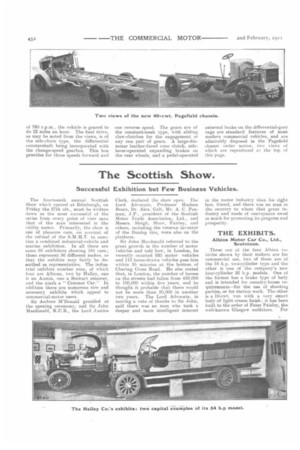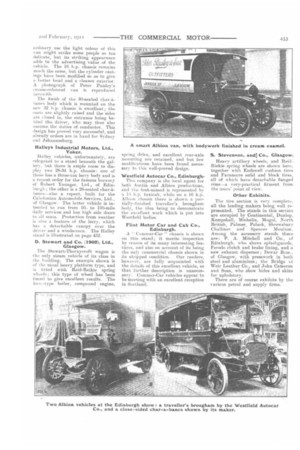The Scottish Show.
Page 16

Page 17

If you've noticed an error in this article please click here to report it so we can fix it.
Successful Exhibition but Few Business Vehicles.
The fourteenth annual Scottish Show which opened at Li' linburgli, on Friday the 27th ult., must be written down as the most successful of the series from every point of view save that of the man interested in the utility motor. Primarily, the show is one of pleasure cars, on account of the refusal of the S.M.M.T. to sanction a combined industrial-vehicle and marine exhibition. In all there are some 95 exhibitors showing 184 cars; these represent 56 different makes, so that the exhibits may fairly be described as representative. The industrial exhibits number nine, of which four are Albions, two by Halley, one is an Austin, one a Stewart steamer, and the ninth a " Commer Car." In addition there are numerous tire and accessory exhibits which appeal to oonunercial-motor users.
Sir Andrew WDonald presided at the opening ceremony, and Sir John Macdonald, K.C.B., the Lord Justice
Clerk, declared the show open. The Lord Advocate, Professor Hudson Beare, Dr. Alex. Galt, Mr. A. C. Penman, 3.P., president of the Scottish Motor Trade Association, Ltd., and Messrs. Sleigh, Shaw, Fairley, and others, including the veteran inventor of the Dunlop tire, were also on the platform.
Sir John Macdonald referred to the great growth in the number of motor vehicles and told how, in London, he recently counted 935 motor vehicles and no horse-drawn vehicles pass him within 35 minutes at the bottom of Charing Cross Road. He also stated that, in London, the number of horses on the streets had fallen from 450,000 to 100,000 within five years, and he thought it probable that there would not be more than 20,000 in another two years. The Lord Advocate, in moving a vote of thanks to Sir John, said there was no man who took a deeper and more intelligent interest in the motor industry than his right hon. friend, and there was no man in the country to whom that great industry and mode of conveyance owed so much for promoting its progress and prosperity.
THE EXHIBITS.
Albion Motor Car Co., Ltd., Scotstoun.
Three out of the four Albion vehicles shown by their makers are for commercial use, two of them are of the 16 h.p. two-cylinder typo and the other is one of the company's new four-cylinder 32 h.p. models. One of the former has a brake type of body and is intended for country-house requirements—for the use of shooting patties, or for station work. The other is a 10-cwt. van with a very smart body of light cream finish; it has been built to the order of Peter Paisley, the well-known Glasgow outfitters, For ordinary use the light colour of this van might strike some people as too delicate, but its striking appearance adds to the advertising value of the vehicle. The 16 h.p. chassis remains much the same, but the cylinder castings have been modified so as to give a better head and a cleaner exterior. A pliotograph of Peter Paisley's cream-coloured van is reproduced herewith
The finish of the 30-seated char-abanes body which is mounted on the new 32 h.p. chassis is excellent; the seats are slightly raised and the sides are closed in, the entrance being behind tho driver, who may thus also assume the duties of conductor. This design has proved very successful, and already orders are in hand for Sydney and Johannesburg.
Halleys Industrial Motors, Ltd., Yoker.
Halley vehicles, unfortunately, are relegated to a stand beneath the gallery, but there is ample room to display two 28-34 h.p. chassis: one of these has a three-ton lorry body and is a repeat order for the famous brewery of Robert Younger, Ltd., of Edinburgh; the other is a 26-seated char-abancs—also a repeat, built for the Caledonian Automobile Services, Ltd., of Glasgow. The latter vehicle is intended to run from 50to 100-mile daily services and has high side doors to all seats. Protection from weather is also a feature of the lorry, which has a detachable canopy over the driver and a windscreen. The Halley stand is illustrated on page 452.
D. Stewart and Co. (1902), Ltd., Glasgow.
The Stewart-Thornycroft wagon is the only steam vehicle of its class in the building. The example shown is of the uStial heavy platform type, and is fitted with Reid-Reikie spring wheels; this type of wheel has been found to give excellent results. The loco.-type boiler, compound engine, spring drive, and excellent rear-axle mounting are retained, and but few modifications have been found necessary to this well-proved design.
Westfield Autocar Co., Edinburgh.
This company is the local agent for both Austin and Albion productions, and the first-named is represented by a 15 h.p. taxicab, while on a 16 h.p. Albion chassis there is shown a partially-fieished traveller's brougham body, the idea being to demonstrate the excellent work which is put into Westfield bodies
Flint Motor Car and Cab Co., Edinburgh.
A " Commer-Car " chassis is shown on this stand; it merits inspection by reason of its many interesting features, and also on acoount of its being the only commercial chassis shown in its stripped condition. Our readers, however, are fully acquainted with the details of this excellent vehicle, so that further description is unnecessary. Commer-Car vehicles appear to be meeting with an excellent reception in Scotland. S. Stevenson, and; Co., Glasgow.
Heavy artillery wheels, and ReidRiekie spring wheels are shown here, together with Endswell cushion tires and Faransure solid and block tires, all of which have detachable flanged rims—a very-practical fitment from the users' point of view.
Other Exhibits.
The tire section is very complete, all the leading makers being well represented. The stands in this section are occupied by Continental, Dunlop. Kempshall, Michelin, Mogul, North British, Palmer, Polack, Shrewsbury Challiner and Spencer Moulton. Among the accessory stands there are: P. A. Mitchell and Co., of Edinburgh, who shows splashguards, Ferodo clutch and brake lining, and a new exhaust disperser; Dewar Bros., of Glasgow, with presswork in both steel and aluminium; the Bridge of Weir Leather Co., and John Cameron and Sons, who show hides and skins for upholstery.
There are of course exhibits by the various petrol and supply firms.






















